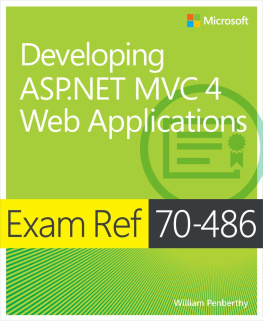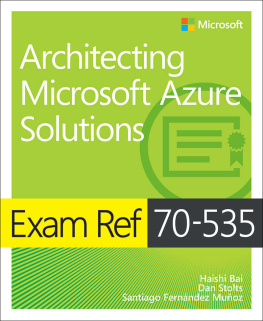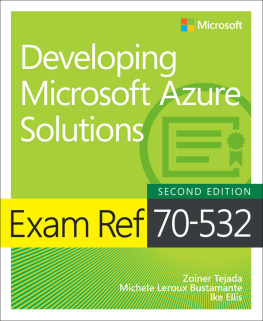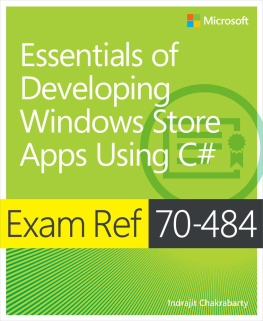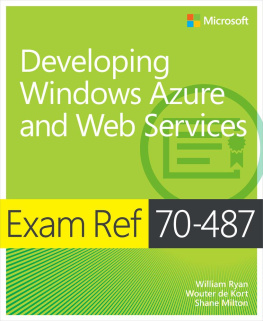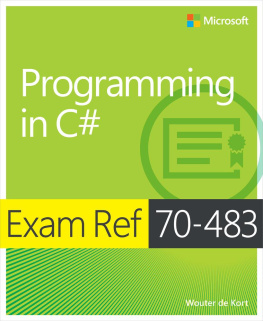Exam Ref 70-486: Developing ASP.NET MVC 4 Web Applications
William Penberthy
Published by Microsoft Press
Special Upgrade Offer
If you purchased this ebook directly from oreilly.com, you have the following benefits:
DRM-free ebooksuse your ebooks across devices without restrictions or limitations
Multiple formatsuse on your laptop, tablet, or phone
Lifetime access, with free updates
Dropbox syncingyour files, anywhere
If you purchased this ebook from another retailer, you can upgrade your ebook to take advantage of all these benefits for just $4.99. to access your ebook upgrade.
Please note that upgrade offers are not available from sample content.
Introduction
The Microsoft 70-486 certification exam tests your knowledge of designing, developing, and troubleshooting ASP.NET MVC 4 web applications using Microsoft Visual Studio 2012. Readers are assumed to be experienced Microsoft ASP.NET web application developers with two or more years developing MVC-based solutions.
Most books take a very low-level approach, teaching you how to use individual classes and accomplish fine-grained tasks. Like the Microsoft 70-486 certification exam, this book takes a high-level approach, building on your knowledge of lower-level web application development and extending it into application design. Both the exam and the book are so high-level that there is very little coding involved. In fact, most of the code samples this book provides simply illustrate higher-level concepts.
Success on the 70-486 exam will prove your knowledge and experience in designing and developing web applications using Microsoft technologies. This exam preparation guide reviews the concepts described in the exam objectives, such as the following:
Designing the application architecture
Designing the user interface
Developing the user interface
Troubleshooting and debugging web applications
Designing and implementing security
This book covers every exam objective, but it does not cover every exam question. Only the Microsoft exam team has access to the exam questions themselves and Microsoft regularly adds new questions to the exam, making it impossible to cover specific questions. You should consider this book a supplement to your relevant real-world experience and other study materials. If you encounter a topic in this book that you do not feel completely comfortable with, use the links youll find in text to find more information and take the time to research and study the topic. Great information is available on MSDN, TechNet, and in blogs and forums.
Microsoft certifications
Microsoft certifications distinguish you by proving your command of a broad set of skills and experience with current Microsoft products and technologies. The exams and corresponding certifications are developed to validate your mastery of critical competencies as you design and develop, or implement and support, solutions with Microsoft products and technologies both on-premise and in the cloud. Certification brings a variety of benefits to the individual and to employers and organizations.
More Info All Microsoft Certifications
For information about Microsoft certifications, including a full list of available certifications, go to http://www.microsoft.com/learning/en/us/certification/cert-default.aspx .
Acknowledgments
This book would not have been possible without the patient and loving support of my wife Jeanine, who had to take over much of the responsibility of running a family so I could mutter to myself in the corner and click away on a keyboard. Many thanks also go out to my editor, Kim Lindros, who patiently walked this first-time author through the process of building a book.
Appreciation also goes out to Andre Tournier and Damien Foggon for keeping me on the straight and narrow, and to Jeff Riley from Box Twelve Communications for giving me this opportunity. Finally, I need to acknowledge you, the reader, for your desire to continue your own growth as a developer. Your efforts to improve your skills make us all work to improve ourselves to keep up. Kudos to you, and keep raising the bar!
Errata & book support
Weve made every effort to ensure the accuracy of this book and its companion content. Any errors that have been reported since this book was published are listed on our Microsoft Press site at oreilly.com:
http://aka.ms/ER70-486/errata
If you find an error that is not already listed, you can report it to us through the same page.
If you need additional support, email Microsoft Press Book Support at .
Please note that product support for Microsoft software is not offered through the addresses above.
We want to hear from you
At Microsoft Press, your satisfaction is our top priority, and your feedback our most valuable asset. Please tell us what you think of this book at:
http://www.microsoft.com/learning/booksurvey
The survey is short, and we read every one of your comments and ideas. Thanks in advance for your input!
Stay in touch
Lets keep the conversation going! Were on Twitter: http://twitter.com/MicrosoftPress .
Preparing for the exam
Microsoft certification exams are a great way to build your resume and let the world know about your level of expertise. Certification exams validate your on-the-job experience and product knowledge. While there is no substitution for on-the-job experience, preparation through study and hands-on practice can help you prepare for the exam. We recommend that you round out your exam preparation plan by using a combination of available studymaterials and courses. For example, you might use the training kit and another study guide for your at home preparation, and take a Microsoft Official Curriculum course for the classroom experience. Choose the combination that you think works best for you.
Note that this training kit is based on publically available information about the exam and the authors experience. To safeguard the integrity of the exam, authors do not have access to the live exam.
Chapter 1. Design the application architecture
Every application must have an architecture, but plenty of applications have been created with architectures that were not well considered. As a developer, you should design your solutions architecture to fulfill application requirements and create a robust and high-performing application.
Start by determining the most appropriate way to build your application and then decide how and where it will be deployed. After you have narrowed down the deployment plan, whether on- or off-premise or across multiple physical machines, you can decide how best to fulfill your other application needs. Perhaps data must be stored in a database or the client needs to check in regularly with the server. Some applications might need to be distributed on a server farm, have 99.999 percent availability, serve thousands of pages an hour, or support hundreds of concurrent users. You must consider all of this information as you choose and design your applications architecture.
Objectives in this chapter:
Objective 1.1: Plan the application layers
An application is simply a set of functionality: a screen or set of screens that displays information, a way to persist data across uses, and a way to make business decisions. A layer

